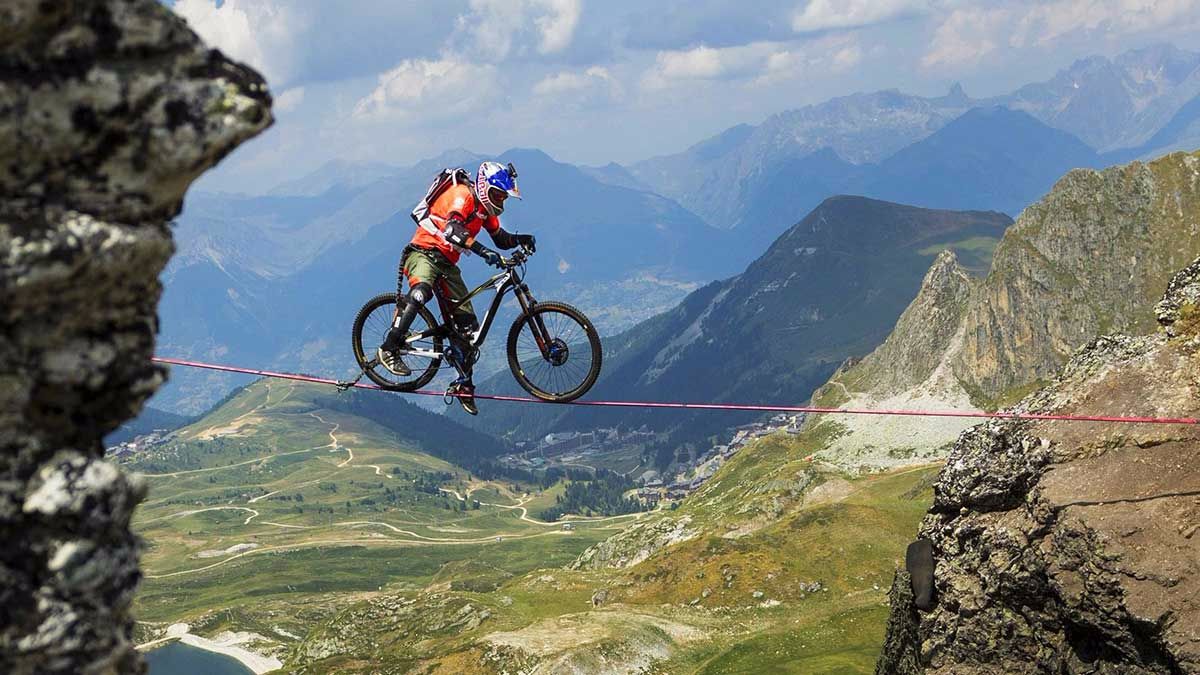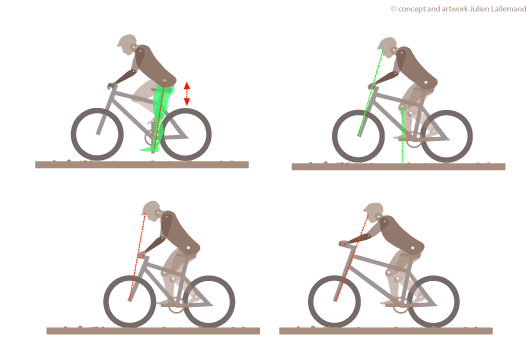Blog
Skills for Mountain Biking – A Guide [2]

Riding a mountain bike well means maintaining your balance during any type of bump or bump. It's not just about sitting firmly on the seat. If you hit a rock, the bike will transfer all the energy of the impact to your back and you'll fall. That's why your legs and arms are the best shock absorbers: they don't transfer the force of the impact to your upper body.
Bicycle adjustment
For proper balancing, you need a bike that is the right size for you. Here are some very simple recommendations for choosing the right bike.

Chair height:
To find out if a bike is the right size for you, you need to adjust it to the “optimal position” so that this position allows you to fully utilize your leg strength.
- Sit on the bike. Place your heel on the pedals.
- You should reach the pedal with your heel and your foot extended. If your heel reaches the pedal and your foot is bent, it means you are too low.
- Ride the bike for a minute and make sure your hips don't move to reach your ankles – if so, your seat is too high.
- Measure or mark the position of the chair. Remember this measurement, it is the “optimal” height.
- It may feel like you're too high off the ground, but try to get used to it—your feet shouldn't touch the ground when you're riding a mountain bike. If you're experiencing too much discomfort, lower your seat height by just ½ or 1 inch.
Bicycle length:
Golden rule: When you sit on your bike, you should be able to see your front drive axle (or hub) because the wheel covers it. If you can see it in front of the wheel, the bike is too small for you; if you can see the front axle behind the wheel, the bike is too big for you.
Correct sitting:
- When you sit on the bike and pedal, your arms should be slightly relaxed. This is necessary for you to be able to steer.
- You should keep your thumb down on the steering wheel, like you would hold a tennis racket. Hands On the wheel from above No Let's start. – This may cause you to completely lose control of the bike.

Get on the bike.
As soon as the terrain becomes rough or unstable, you should step on the pedals, not stay on the seat. You won't be able to overcome an obstacle by sitting softly on the seat.
On the picture: The center of gravity is between the two wheels. Push yourself up on the bench and push your hips back to prepare for the impact of the impact.

Think of your heart as the center of gravity that you want to keep as stable as possible. To do this, you need to use your legs and arms, they are your shock absorbers. They will help keep your center of gravity stable by absorbing sudden impacts and balancing the bike.
Now imagine a line that runs vertically from your heart to the ground at one point – this is the projection of your center of gravity on the ground. If you are sitting correctly on a bicycle, this point is in the middle of your wheel line. You should keep this point as close to the center as possible, or slightly back. Moving this point forward increases the chance of the handlebars falling over.
Tiger position
If the terrain becomes uneven, adopting a low stance allows you to have more flexibility in your arms and legs. Not only does the bike hit obstacles, it also wobbles and falls. Without the weight of your weight on the tires to maintain constant contact with the ground, you can neither steer nor brake. Leaning on your bike is the only way to keep the tires on the ground when you're riding steep and dangerous trails.
In the photo: A bent-over pose to transition to elevation

Exercise: Find your balance
- Find a flat place where you can walk 100 meters at a moderate pace.
- Build enough speed to be able to "cruise" for 50 meters.
- Stand on the pedals; make sure the crank is horizontal.
- Rise from the chair only 2.54 cm (1 inch): Keep your legs bent.
- As you stand, push the seat back and bend your arms. Your upper body should lean toward the frame. You can lightly hold the chair with the inside of your thighs.
- It is important to look forward, never at your hands or the front wheel.

What is a good balance?
- Your weight should be almost completely off your arms. It's wrong if you're pushing too hard on the steering wheel, and it's also wrong if you're leaning too far away from the steering wheel. You should be completely balanced on your feet.
- How to check your balance: Hold the chair lightly with your inner thigh and try to put just two fingers on the wheel. Then try to let go of the wheel.
Now, examine your range of motion:
- Try again and again and bend as low as you can. You will notice that it is very easy to find your balance when you reach the lowest position.
- Now the turn:
- Sitting hunched over while the bike is rocking allows you to spread your arms and legs. It also allows you to reach your arms forward so you can turn.
- If your arms are fully extended, you won't be able to steer, so be careful and never "hang" on the wheel.
On the picture: The bike sways in different ways, yet your center of gravity must remain stable at all times.

Exercise: Maintaining balance while descending a slope
Please reread the first chapter on braking, as you will need to brake when going downhill.
- Look for a wide, sweeping slope that gradually becomes steeper and ends with a field.
- Sit on the bike; cruise down the road, keeping your pedals horizontal.
- Brake to descend moderately slowly.
- Push yourself up onto the bench, pushing your hips back until you feel the bench between your inner thighs, while bending your arms. Your upper body should be close to the frame (of the bike).
- Look ahead and think about how far you have to go to brake and come to a complete stop. Don't stop looking ahead carefully.
- Do not slouch on the bike (too forward posture) or push yourself up (too backward posture). Your arms should always be loose and flexible.

- It may feel strange to bend your body down when landing, but this position allows you to have more flexibility in your arms, gives you control, and neutralizes the force of the impact.
Exercise: Turns on a slope
- Repeat the previous exercise, but this time try slaloming on the steepest part of the slope. You can place stones every 5 meters to create a slalom.
- Always control your speed, don't allow yourself to just follow the slope.
- If you can't turn, it means you're leaning too far back and your arms are too tight to control.
Conclusion: A hunched posture is the foundation of good cycling technique when the terrain is fast, loose, or rough and winding (and maybe even all of these!). This will allow you to push up on your bike (jump). Being able to spread your arms freely will allow you to swing and turn easily. This exercise will give you experience with bench presses and will give you an idea of how far you can push back without losing your balance. The lower you go, the more you will be able to maintain your balance and overcome obstacles and difficulties. This skill will come in handy when you are riding very rough surfaces, hills, and curves.
Translated and edited by Tea Gulua and James Dean

